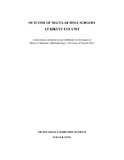| dc.contributor.author | Kudrati, Mufaddal Fakhruddin | |
| dc.date.accessioned | 2015-08-31T06:10:17Z | |
| dc.date.available | 2015-08-31T06:10:17Z | |
| dc.date.issued | 2014 | |
| dc.identifier.citation | Master of Medicine (Ophthalmology) | en_US |
| dc.identifier.uri | http://hdl.handle.net/11295/90229 | |
| dc.description.abstract | Purpose: To determine the outcome for Macular Hole surgery at Kikuyu Eye Unit (KEU).
Method: This was a retrospective hospital based case series conducted at Kikuyu Eye Unit. Records of
all patients who underwent macular hole surgery at KEU between January 2008 and July 2013 were
accessed and data related to demography, pre-operative evaluation, surgical details, post-operative follow
up and complications was retrieved. The main outcome measures were hole closure rates, visual outcome
after surgery and complications of macular hole surgery.
Results: A total of 57 eyes of 54 patients who had macular hole surgery were included. The median age
of the patients was 62 years (range 13-82 years) and the female to male ratio was 1.1: 1. Most of the holes
were idiopathic (87.7%) while the rest were traumatic. The patients had a mean duration of symptoms of
13.7 months , SD 15.79 (range 1week-5 years) and the average delay between diagnosis and surgery was
2.4 months, SD 2.15 (range 1week-3 months).The mean hole size was 578μm,SD 230.14 (range 2001100μm).
46 eyes (80.7%) underwent standard ILM (internal limiting membrane) peeling while 11 eyes (19.3%)
underwent ILM peel with inverted flap technique. All the eyes were followed up for at least 1 month post
operatively with 93% follow up rate at 3 months,63% at 6 months and 36% at 1 year.
94.7% of eyes had anatomical closure, 83% of which were type 1 closures. 68.42% of the eyes had visual
improvement of ≥ 2 Snellen lines, 15.8% had their pre-op vision preserved while vision deteriorated in 3
eyes.
All the holes which failed to close were > 400μm in size and of > 6 months duration.
Inverted flap technique had better visual outcome for holes ≥ 400μm (p=0.007) and ≥ 6months duration
(p=0.0045) compared to standard ILM peel alone.
Cataract occurred in 44.68% of phakic eyes at a mean of 16 weeks post macular hole surgery. Increase in
IOP was seen in 12.28% of eyes at a mean of 1.2 weeks after surgery. Other complications included
retinal break, localized retinal detachment.
Conclusion: Macular hole surgery was associated with very successful outcomes in a majority of patients
including traumatic holes. The anatomic outcome was better than the visual outcome with 94.7%
achieving anatomic closure compared to 68.42% having visual improvement.
ILM peel with inverted flap technique was associated with better outcomes in older and larger holes
compared to standard ILM peel alone.
The commonest complication post macular hole surgery was cataract followed by increased IOP | en_US |
| dc.language.iso | en | en_US |
| dc.publisher | University of Nairobi | en_US |
| dc.title | Outcome of macular hole surgery at Kikuyu eye unit | en_US |
| dc.type | Thesis | en_US |
| dc.description.department | a
Department of Psychiatry, University of Nairobi, ; bDepartment of Mental Health, School of Medicine,
Moi University, Eldoret, Kenya | |
| dc.type.material | en_US | en_US |

